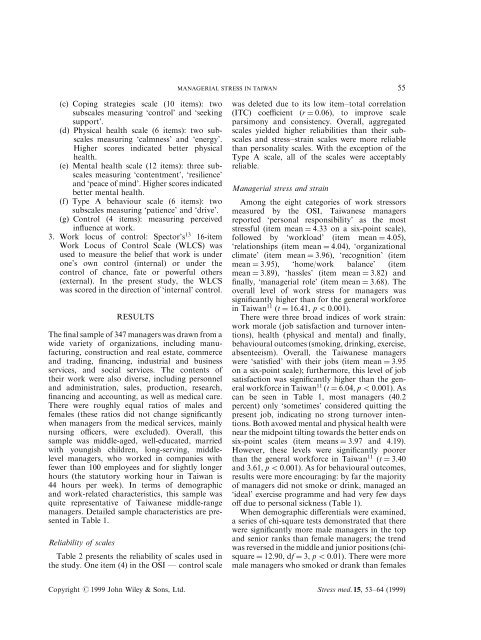Managerial stress, job satisfaction and health in Taiwan
Managerial stress, job satisfaction and health in Taiwan
Managerial stress, job satisfaction and health in Taiwan
Create successful ePaper yourself
Turn your PDF publications into a flip-book with our unique Google optimized e-Paper software.
MANAGERIAL STRESS IN TAIWAN 55(c) Cop<strong>in</strong>g strategies scale (10 items): twosubscales measur<strong>in</strong>g `control' <strong>and</strong> `seek<strong>in</strong>gsupport'.(d) Physical <strong>health</strong> scale (6 items): two subscalesmeasur<strong>in</strong>g `calmness' <strong>and</strong> `energy'.Higher scores <strong>in</strong>dicated better physical<strong>health</strong>.(e) Mental <strong>health</strong> scale (12 items): three subscalesmeasur<strong>in</strong>g `contentment', `resilience'<strong>and</strong> `peace of m<strong>in</strong>d'. Higher scores <strong>in</strong>dicatedbetter mental <strong>health</strong>.(f) Type A behaviour scale (6 items): twosubscales measur<strong>in</strong>g `patience' <strong>and</strong> `drive'.(g) Control (4 items): measur<strong>in</strong>g perceived<strong>in</strong>¯uence at work.3. Work locus of control: Spector's 13 16-itemWork Locus of Control Scale (WLCS) wasused to measure the belief that work is underone's own control (<strong>in</strong>ternal) or under thecontrol of chance, fate or powerful others(external). In the present study, the WLCSwas scored <strong>in</strong> the direction of `<strong>in</strong>ternal' control.RESULTSThe ®nal sample of 347 managers was drawn from awide variety of organizations, <strong>in</strong>clud<strong>in</strong>g manufactur<strong>in</strong>g,construction <strong>and</strong> real estate, commerce<strong>and</strong> trad<strong>in</strong>g, ®nanc<strong>in</strong>g, <strong>in</strong>dustrial <strong>and</strong> bus<strong>in</strong>essservices, <strong>and</strong> social services. The contents oftheir work were also diverse, <strong>in</strong>clud<strong>in</strong>g personnel<strong>and</strong> adm<strong>in</strong>istration, sales, production, research,®nanc<strong>in</strong>g <strong>and</strong> account<strong>in</strong>g, as well as medical care.There were roughly equal ratios of males <strong>and</strong>females (these ratios did not change signi®cantlywhen managers from the medical services, ma<strong>in</strong>lynurs<strong>in</strong>g ocers, were excluded). Overall, thissample was middle-aged, well-educated, marriedwith youngish children, long-serv<strong>in</strong>g, middlelevelmanagers, who worked <strong>in</strong> companies withfewer than 100 employees <strong>and</strong> for slightly longerhours (the statutory work<strong>in</strong>g hour <strong>in</strong> <strong>Taiwan</strong> is44 hours per week). In terms of demographic<strong>and</strong> work-related characteristics, this sample wasquite representative of <strong>Taiwan</strong>ese middle-rangemanagers. Detailed sample characteristics are presented<strong>in</strong> Table 1.Reliability of scalesTable 2 presents the reliability of scales used <strong>in</strong>the study. One item (4) <strong>in</strong> the OSI Ð control scalewas deleted due to its low item±total correlation(ITC) coecient (r ˆ 0.06), to improve scaleparsimony <strong>and</strong> consistency. Overall, aggregatedscales yielded higher reliabilities than their subscales<strong>and</strong> <strong>stress</strong>±stra<strong>in</strong> scales were more reliablethan personality scales. With the exception of theType A scale, all of the scales were acceptablyreliable.<strong>Managerial</strong> <strong>stress</strong> <strong>and</strong> stra<strong>in</strong>Among the eight categories of work <strong>stress</strong>orsmeasured by the OSI, <strong>Taiwan</strong>ese managersreported `personal responsibility' as the most<strong>stress</strong>ful (item mean ˆ 4.33 on a six-po<strong>in</strong>t scale),followed by `workload' (item mean ˆ 4.05),`relationships (item mean ˆ 4.04), `organizationalclimate' (item mean ˆ 3.96), `recognition' (itemmean ˆ 3.95), `home/work balance' (itemmean ˆ 3.89), `hassles' (item mean ˆ 3.82) <strong>and</strong>®nally, `managerial role' (item mean ˆ 3.68). Theoverall level of work <strong>stress</strong> for managers wassigni®cantly higher than for the general workforce<strong>in</strong> <strong>Taiwan</strong> 11 (t ˆ 16.41, p 5 0.001).There were three broad <strong>in</strong>dices of work stra<strong>in</strong>:work morale (<strong>job</strong> <strong>satisfaction</strong> <strong>and</strong> turnover <strong>in</strong>tentions),<strong>health</strong> (physical <strong>and</strong> mental) <strong>and</strong> ®nally,behavioural outcomes (smok<strong>in</strong>g, dr<strong>in</strong>k<strong>in</strong>g, exercise,absenteeism). Overall, the <strong>Taiwan</strong>ese managerswere `satis®ed' with their <strong>job</strong>s (item mean ˆ 3.95on a six-po<strong>in</strong>t scale); furthermore, this level of <strong>job</strong><strong>satisfaction</strong> was signi®cantly higher than the generalworkforce <strong>in</strong> <strong>Taiwan</strong> 11 (t ˆ 6.04, p 5 0.001). Ascan be seen <strong>in</strong> Table 1, most managers (40.2percent) only `sometimes' considered quitt<strong>in</strong>g thepresent <strong>job</strong>, <strong>in</strong>dicat<strong>in</strong>g no strong turnover <strong>in</strong>tentions.Both avowed mental <strong>and</strong> physical <strong>health</strong> werenear the midpo<strong>in</strong>t tilt<strong>in</strong>g towards the better ends onsix-po<strong>in</strong>t scales (item means ˆ 3.97 <strong>and</strong> 4.19).However, these levels were signi®cantly poorerthan the general workforce <strong>in</strong> <strong>Taiwan</strong> 11 (t ˆ 3.40<strong>and</strong> 3.61, p 5 0.001). As for behavioural outcomes,results were more encourag<strong>in</strong>g: by far the majorityof managers did not smoke or dr<strong>in</strong>k, managed an`ideal' exercise programme <strong>and</strong> had very few dayso€ due to personal sickness (Table 1).When demographic di€erentials were exam<strong>in</strong>ed,a series of chi-square tests demonstrated that therewere signi®cantly more male managers <strong>in</strong> the top<strong>and</strong> senior ranks than female managers; the trendwas reversed <strong>in</strong> the middle <strong>and</strong> junior positions (chisquareˆ 12.90, df ˆ 3, p 5 0.01). There were moremale managers who smoked or drank than femalesCopyright # 1999 John Wiley & Sons, Ltd. Stress med. 15, 53±64 (1999)
















